ROTATIONAL AXIS
Uranus' rotational axis is strongly tilted on its side (97.9°). Instead of rotating with its axis roughly perpendicular to the plane of its orbit (like all the other planets in our Solar System), Uranus rotates on its side (along its orbital path). This tipped rotational axis gives rise to extreme seasons on Uranus.
Because of its almost-perpendicular axis orientation, there is a debate over which of Uranus' poles is its north pole. This debates leads to yet another: Is Uranus spinning in a retrograde orbit (like Venus) or not (like the other planets)?
SIZE
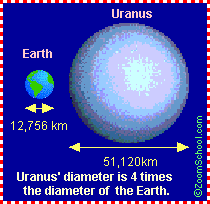 Uranus is about 31,690 miles (51,118 km) in diameter. This is about 4 times the diameter of the Earth.
Uranus is about 31,690 miles (51,118 km) in diameter. This is about 4 times the diameter of the Earth.
This gas giant is the third-largest planet in our Solar System (after Jupiter and Saturn).
MASS AND GRAVITY
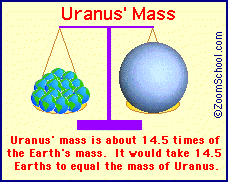 Uranus' mass is about 8.68 x 1025 kg. This is about 14 times the mass of the Earth. The gravity on Uranus is only 91% of the gravity on Earth. This is because it is such a large planet (and the gravitational force a planet exerts upon an object at the planet's surface is proportional to its mass and to the inverse of its radius squared).
Uranus' mass is about 8.68 x 1025 kg. This is about 14 times the mass of the Earth. The gravity on Uranus is only 91% of the gravity on Earth. This is because it is such a large planet (and the gravitational force a planet exerts upon an object at the planet's surface is proportional to its mass and to the inverse of its radius squared).
A 100-pound person on Uranus would weigh 91 pounds.
LENGTH OF A DAY AND YEAR ON URANUS
 Each day on Uranus takes 17.9 Earth hours. A year on Uranus takes 84.07 Earth years; it takes 84.07 Earth years for Uranus to orbit the sun once.
Each day on Uranus takes 17.9 Earth hours. A year on Uranus takes 84.07 Earth years; it takes 84.07 Earth years for Uranus to orbit the sun once.
URANUS' ORBIT AND DISTANCE FROM THE SUN
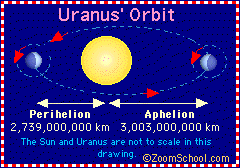 Uranus is over 19 times as far from the Sun as the Earth is; it averages 19.18 A.U.
Uranus is over 19 times as far from the Sun as the Earth is; it averages 19.18 A.U.
At aphelion (the farthest point in its solar orbit) it is 1,850,000,000 miles (3,003,000,000 km) from the Sun. At perihelion (the closest point in its solar orbit) it is 1,700,000,000 miles (2,739,000,000 km) from the Sun.
 TEMPERATURE
TEMPERATURE
The mean temperature on the surface of Uranus' cloud layer is -350°F (59 K). Uranus radiates very little heat in comparison with the other gas giants, Jupiter, Saturn and Neptune).
PLANETARY COMPOSITION AND ATMOSPHERE
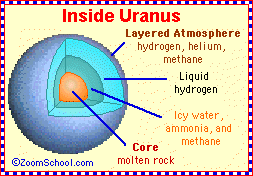 Uranus is a frozen, gaseous planet with a molten core. Uranus' atmosphere consists of 83% hydrogen, 15% helium and 2% methane.
Uranus is a frozen, gaseous planet with a molten core. Uranus' atmosphere consists of 83% hydrogen, 15% helium and 2% methane.
RINGS
MOONS
Uranus has 5 large moons (2 were discovered by Wm. Herschel in 1781, 2 were discovered by Wm. Lassell in 1851, and one by G. Kuiper in 1948) and many small moons (which were discovered much later).
DISCOVERY OF URANUS
Uranus was discovered by the British astronomer William Herschel on March 13, 1781. Herschel also discovered two of the moons of Uranus (Titania and Oberon) and some of the moons of Saturn.
URANUS-EARTH COMPARISON
SIZE
This gas giant is the third-largest planet in our Solar System (after Jupiter and Saturn).
MASS AND GRAVITY
A 100-pound person on Uranus would weigh 91 pounds.
LENGTH OF A DAY AND YEAR ON URANUS
URANUS' ORBIT AND DISTANCE FROM THE SUN
At aphelion (the farthest point in its solar orbit) it is 1,850,000,000 miles (3,003,000,000 km) from the Sun. At perihelion (the closest point in its solar orbit) it is 1,700,000,000 miles (2,739,000,000 km) from the Sun.
The mean temperature on the surface of Uranus' cloud layer is -350°F (59 K). Uranus radiates very little heat in comparison with the other gas giants, Jupiter, Saturn and Neptune).
PLANETARY COMPOSITION AND ATMOSPHERE
RINGS
|
MOONS
Oberon, the largest moon of Uranus. Photo taken by NASA's Voyager mission in 1986. |
DISCOVERY OF URANUS
Uranus was discovered by the British astronomer William Herschel on March 13, 1781. Herschel also discovered two of the moons of Uranus (Titania and Oberon) and some of the moons of Saturn.
URANUS-EARTH COMPARISON
URANUS' NAME AND SYMBOL
This is the symbol of the planet Uranus. |
SPACECRAFT VISITS
Uranus has been visited by NASA's Voyager 2, whose closest approach was on January 24, 1986.
URANUS' ROTATIONAL TILT AND EXTREME SEASONS
Uranus' rotational axis is strongly tilted on its side (97.9°). Instead of rotating with its axis roughly perpendicular to the plane of its orbit (like all the other planets in our Solar System), Uranus rotates on its side (along its orbital path). This tipped rotational axis gives rise to extreme seasons on Uranus.
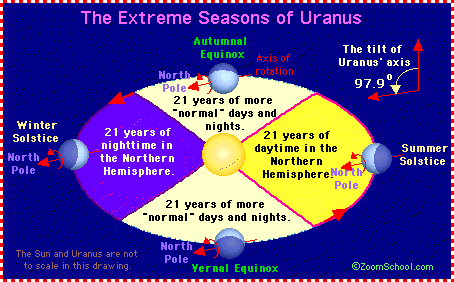
A catastrophic collision with another large body eons ago may have tipped Uranus over on its side.
A catastrophic collision with another large body eons ago may have tipped Uranus over on its side.
INSIDE URANUS
PLANETARY COMPOSITION AND ATMOSPHERE
PLANETARY COMPOSITION AND ATMOSPHERE
Atmosphere: The planet is shrouded in an icy cloud layer (made up of frozen methane, ethane, and acetylene) circling this planet at 185 mph (300 kph. Uranus' icy atmosphere consist of 83% hydrogen,15% helium, and 2% methane. The outer layers of the atmosphere are the coldest; temperature and pressure rise under the cloud layer.
Partially-solid Layers: Beneath the atmosphere, there is a liquid layer of hydrogen and helium. As depth increases, this layer becomes more viscous, and then partly solid. This layer may be composed of compressed water with ammonia and methane.
Core: Uranus has a molten rocky core about 10,500 miles (17,000 km) in diameter and about 12,500°F (6927°C). This core may have a mass five times greater than the mass of the Earth.
URANUS' RINGS
|
|
| Uranus Statistics | |
|---|---|
| Discovered by | William Herschel |
| Date of discovery | 1781 |
| Mass (kg) | 8.686e+25 |
| Mass (Earth = 1) | 1.4535e+01 |
| Equatorial radius (km) | 25,559 |
| Equatorial radius (Earth = 1) | 4.0074 |
| Mean density (gm/cm^3) | 1.29 |
| Mean distance from the Sun (km) | 2,870,990,000 |
| Mean distance from the Sun (Earth = 1) | 19.1914 |
| Rotational period (hours) | -17.9 |
| Orbital period (years) | 84.01 |
| Mean orbital velocity (km/sec) | 6.81 |
| Orbital eccentricity | 0.0461 |
| Tilt of axis (degrees) | 97.86 |
| Orbital inclination (degrees) | 0.774 |
| Equatorial surface gravity (m/sec^2) | 7.77 |
| Equatorial escape velocity (km/sec) | 21.30 |
| Visual geometric albedo | 0.51 |
| Magnitude (Vo) | 5.52 |
| Mean cloud temperature | -193°C |
| Atmospheric pressure (bars) | 1.2 |
| Atmospheric composition Hydrogen Helium Methane | 83% 15% 2% |
No comments:
Post a Comment